1. Warner JJ, Harrington RA, Sacco RL, Elkind MS. Guidelines for the early management of patients with acute ischemic stroke: 2019 update to the 2018 guidelines for the early management of acute ischemic stroke. Stroke. 2019; 50(12):3331–3332. PMID:
31662117.

2. Saver JL, Goyal M, van der Lugt A, Menon BK, Majoie CB, Dippel DW, et al. Time to treatment with endovascular thrombectomy and outcomes from ischemic stroke: a meta-analysis. JAMA. 2016; 316(12):1279–1288. PMID:
27673305.

3. Saver JL, Fonarow GC, Smith EE, Reeves MJ, Grau-Sepulveda MV, Pan W, et al. Time to treatment with intravenous tissue plasminogen activator and outcome from acute ischemic stroke. JAMA. 2013; 309(23):2480–2488. PMID:
23780461.

4. Messé SR, Khatri P, Reeves MJ, Smith EE, Saver JL, Bhatt DL, et al. Why are acute ischemic stroke patients not receiving IV tPA? Results from a national registry. Neurology. 2016; 87(15):1565–1574. PMID:
27629092.
5. Powers WJ, Rabinstein AA, Ackerson T, Adeoye OM, Bambakidis NC, Becker K, et al. 2018 guidelines for the early management of patients with acute ischemic stroke: a guideline for healthcare professionals from the American Heart Association/American Stroke Association. Stroke. 2018; 49(3):e46–110. PMID:
29367334.

6. Lin CB, Peterson ED, Smith EE, Saver JL, Liang L, Xian Y, et al. Emergency medical service hospital prenotification is associated with improved evaluation and treatment of acute ischemic stroke. Circ Cardiovasc Qual Outcomes. 2012; 5(4):514–522. PMID:
22787065.

7. Fassbender K, Balucani C, Walter S, Levine SR, Haass A, Grotta J. Streamlining of prehospital stroke management: the golden hour. Lancet Neurol. 2013; 12(6):585–596. PMID:
23684084.

8. Kothari RU, Pancioli A, Liu T, Brott T, Broderick J. Cincinnati prehospital stroke scale: reproducibility and validity. Ann Emerg Med. 1999; 33(4):373–378. PMID:
10092713.

9. Kogan E, Twyman K, Heap J, Milentijevic D, Lin JH, Alberts M. Assessing stroke severity using electronic health record data: a machine learning approach. BMC Med Inform Decis Mak. 2020; 20(1):8. PMID:
31914991.

10. Saver JL. Time is brain--quantified. Stroke. 2006; 37(1):263–266. PMID:
16339467.

11. Meretoja A, Strbian D, Mustanoja S, Tatlisumak T, Lindsberg PJ, Kaste M. Reducing in-hospital delay to 20 minutes in stroke thrombolysis. Neurology. 2012; 79(4):306–313. PMID:
22622858.

12. Meretoja A, Weir L, Ugalde M, Yassi N, Yan B, Hand P, et al. Helsinki model cut stroke thrombolysis delays to 25 minutes in Melbourne in only 4 months. Neurology. 2013; 81(12):1071–1076. PMID:
23946303.

13. McKinney JS, Mylavarapu K, Lane J, Roberts V, Ohman-Strickland P, Merlin MA. Hospital prenotification of stroke patients by emergency medical services improves stroke time targets. J Stroke Cerebrovasc Dis. 2013; 22(2):113–118. PMID:
21820919.

14. Patel MD, Rose KM, O'Brien EC, Rosamond WD. Prehospital notification by emergency medical services reduces delays in stroke evaluation: findings from the North Carolina stroke care collaborative. Stroke. 2011; 42(8):2263–2268. PMID:
21659638.
15. Shkirkova K, Akam EY, Huang J, Sheth SA, Nour M, Liang CW, et al. Feasibility and utility of an integrated medical imaging and informatics smartphone system for management of acute stroke. Int J Stroke. 2017; 12(9):953–960. PMID:
28358291.

16. Noone ML, Moideen F, Krishna RB, Pradeep Kumar VG, Karadan U, Chellenton J, et al. Mobile app based strategy improves door-to-needle time in the treatment of acute ischemic stroke. J Stroke Cerebrovasc Dis. 2020; 29(12):105319. PMID:
32992177.

17. Martins SC, Weiss G, Almeida AG, Brondani R, Carbonera LA, de Souza AC, et al. Validation of a smartphone application in the evaluation and treatment of acute stroke in a comprehensive stroke center. Stroke. 2020; 51(1):240–246. PMID:
31847753.

18. Dickson RL, Sumathipala D, Reeves J. Stop stroke(c) acute care coordination medical application: a brief report on postimplementation performance at a primary stroke center. J Stroke Cerebrovasc Dis. 2016; 25(5):1275–1279. PMID:
26971040.
19. Tan BY, Ngiam NJ, Sunny S, Kong WY, Tam H, Sim TB, et al. Improvement in door-to-needle time in patients with acute ischemic stroke via a simple stroke activation protocol. J Stroke Cerebrovasc Dis. 2018; 27(6):1539–1545. PMID:
29422380.

20. De Luca A, Mariani M, Riccardi MT, Damiani G. The role of the Cincinnati Prehospital Stroke Scale in the emergency department: evidence from a systematic review and meta-analysis. Open Access Emerg Med. 2019; 11:147–159. PMID:
31410071.
21. Carr BG, Matthew Edwards J, Martinez R. 2010 Academic Emergency Medicine consensus conference, Beyond Regionalization: Integrated Networks of Care. Regionalized care for time-critical conditions: lessons learned from existing networks. Acad Emerg Med. 2010; 17(12):1354–1358. PMID:
21122020.

22. Sirimarco G, Lavallée PC, Labreuche J, Meseguer E, Cabrejo L, Guidoux C, et al. Overlap of diseases underlying ischemic stroke: the ASCOD phenotyping. Stroke. 2013; 44(9):2427–2433. PMID:
23860300.
23. Fonarow GC, Saver JL, Smith EE, Broderick JP, Kleindorfer DO, Sacco RL, et al. Relationship of national institutes of health stroke scale to 30-day mortality in medicare beneficiaries with acute ischemic stroke. J Am Heart Assoc. 2012; 1(1):42–50. PMID:
23130117.

24. Wu Z, Zeng M, Li C, Qiu H, Feng H, Xu X, et al. Time-dependence of NIHSS in predicting functional outcome of patients with acute ischemic stroke treated with intravenous thrombolysis. Postgrad Med J. 2019; 95(1122):181–186. PMID:
30975729.

25. Lee SH, Mun YH, Ryoo HW, Jin SC, Kim JH, Ahn JY, et al. Delays in the management of patients with acute ischemic stroke during the COVID-19 outbreak period: a multicenter study in Daegu, Korea. Emerg Med Int. 2021; 2021:6687765. PMID:
33833878.

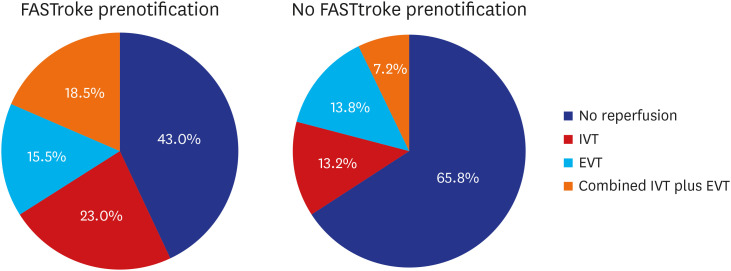
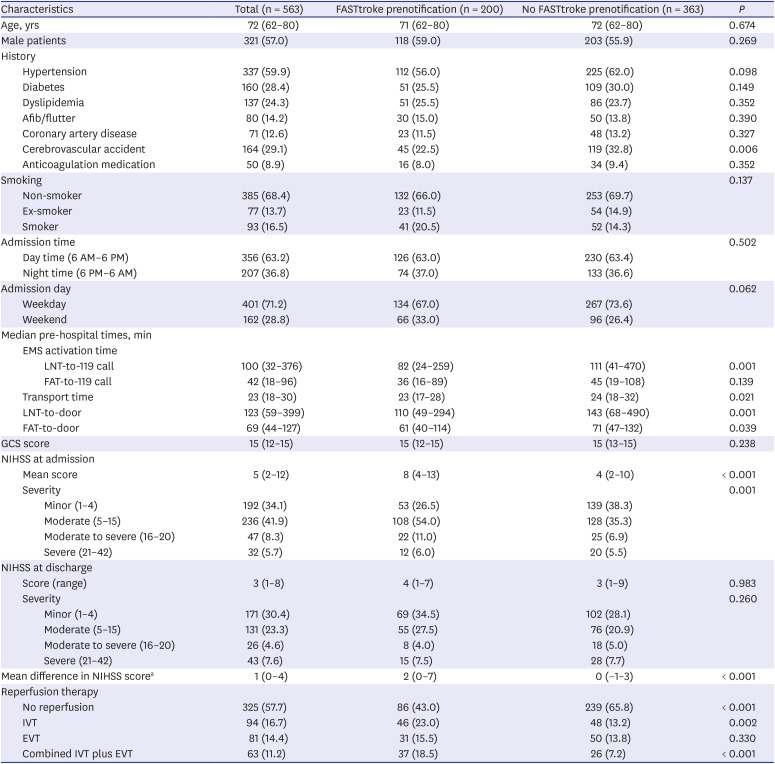

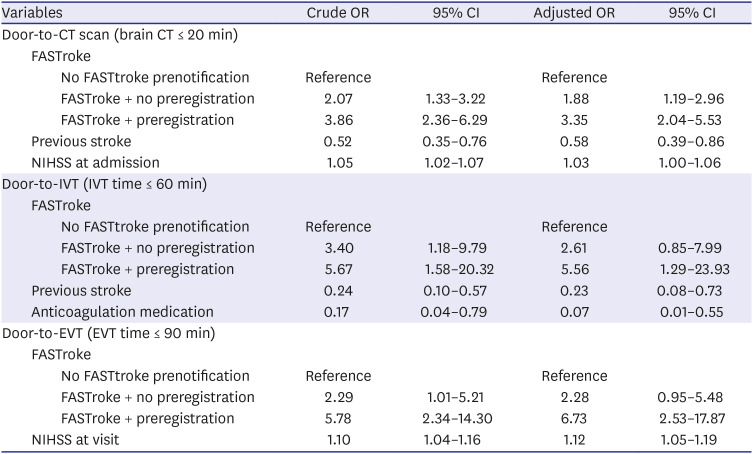




 PDF
PDF Citation
Citation Print
Print



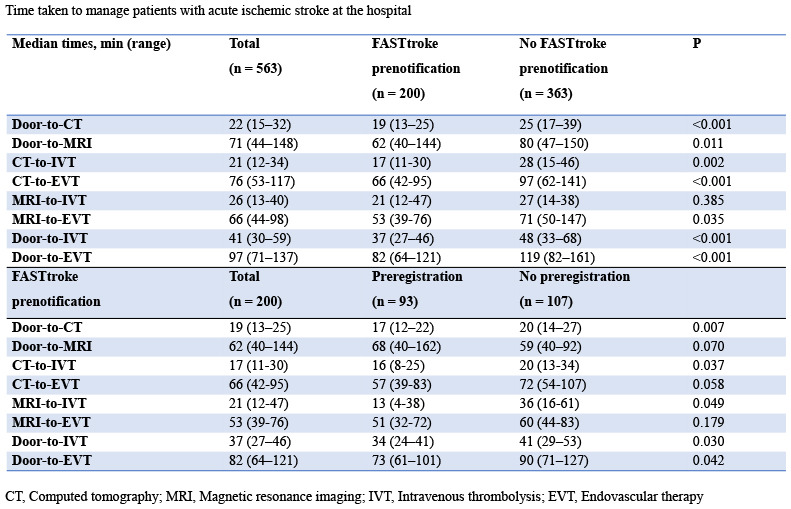
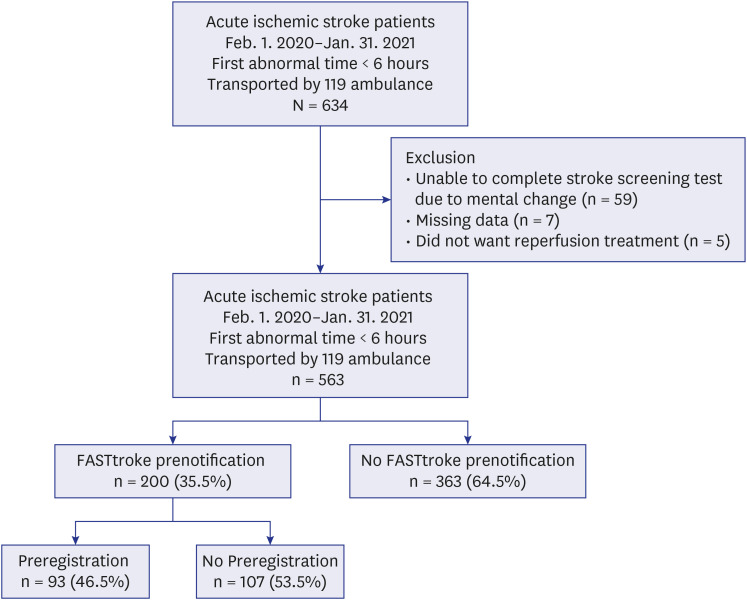
 XML Download
XML Download